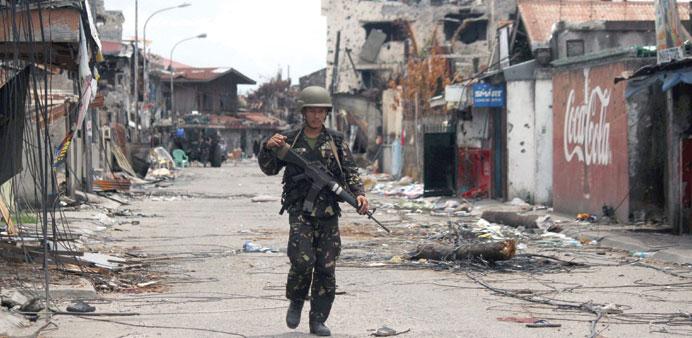AFP/Manila
A military campaign against gunmen opposed to peace talks ended yesterday with close to 500 rebels killed or captured and nearly 200 hostages freed in a key southern city, the army said.
“The threat to Zamboanga is over. The enemy has no organised resistance left,” military spokesman Lieutenant-Colonel Ramon Zagala said on the 20th day of operations.
Police will now take over from troops to clear sections of the vital regional trading centre of Moro National Liberation Front (MNLF) stragglers, and find a key guerrilla leader who remains unaccounted for, he added.
The military said Nur Misuari, who founded the guerrilla group in the early 1970s, had sent hundreds of armed followers, led by his top lieutenant Habier Malik, to Zamboanga three weeks ago in a bid to derail peace talks with a rival Muslim rebel group.
A total of 183 rebels were killed and 292 others were detained in the fighting. However neither Misuari nor Malik have been found. The government believes Misuari has gone into hiding in another area of the south.
Zagala said authorities are checking the identities of some of the slain gunmen to determine whether Malik was among them.
The justice department has also announced plans to file charges of rebellion against detained suspects as well as Misuari.
The fighting claimed the lives of 23 soldiers and policemen, as well as 12 civilians.
The militants seized scores of hostages as they holed up in several coastal districts of the city of onemn people, holding off 4,500 troops sent to root them out.
More than 10,000 homes were razed to the ground in fierce street battles, forcing over 100,000 people - around a tenth of the city’s population - to flee.
Philippine officials said yesterday they believed that all 195 hostages held by the gunmen had either escaped, been rescued or released.
“The indications are that they are no longer holding any hostages,” military spokesman Brigadier-General Domingo Tutaan told reporters in Manila.
Abigail Valte, a spokeswoman for President Benigno Aquino, confirmed that all of those known to have been taken hostage were now accounted for.
“Remember that our task from day one is to ensure the safety of the hostages that were taken... And that’s already been accomplished,” she said on government radio.
Yesterday, Defence Secretary Voltaire Gazmin and Interior Secretary Mar Roxas visited Zamboanga’s Martha Street, the scene of some of the heaviest fighting, to raise the Philippine flag at a warehouse believed to have served as the gunmen’s command post. “We honour the fallen, the brave soldiers and policemen who died for the sake of their country (and) innocent civilians who were sacrificed for the selfish interest of a few,” Roxas told reporters.
Zagala, the military spokesman, said it could take up to two weeks to clear the conflict areas - 30-40 hectares of densely packed communities, mangrove swamps and ponds where fish are raised - of possible MNLF stragglers, unexploded bombs, and booby traps.
Military forces involved in the fighting would remain in the city to support the police, he added.
Valte, the presidential spokeswoman, said government aid agencies would now focus on preparing residents to return to their communities after the police pull out. “We have allotted money for shelter assistance for the families whose homes have been totally destroyed or totally burned down,” she added.
Rebels have been fighting since the 1970s for an independent or autonomous homeland in the south of the mainly Catholic Philippines. An estimated 150,000 people have died in the conflict.
The MNLF signed a peace treaty in 1996 that granted limited self-rule to the south’s
Muslim minority.
However the group is opposed to a planned final peace deal between the government and the remaining major rebel group, the 12,000-strong Moro Islamic Liberation Front.
The MNLF believes the deal could leave it sidelined.

A Philippine soldier walks amongst burned and bullet-riddled houses in Zamboanga.


